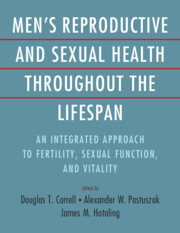 Men's Reproductive and Sexual Health Throughout the Lifespan
Men's Reproductive and Sexual Health Throughout the Lifespan from Section 4 - Laboratory Evaluation and Treatment of Male Infertility
Published online by Cambridge University Press: 06 December 2023
Although semen analysis is the main routine test used in the diagnosis of male infertility, it is considered to be poorly predictive of male fertility status. Only recently, research in sperm biology focused on the development of assays to evaluate sperm functions necessary to reach and fertilize the oocyte and to allow a correct embryo development. However, the clinical utility of the currently proposed tests/assays remains a matter of debate, especially after introduction of ICSI. Ideally, since fertilization proceeds in a cascade-like manner, the goal would be to develop a single test able to evaluate all the aspects involved in this process and introduce it in ART laboratories. Such test should be simple, cheap, and not requiring expensive technology. Unfortunately, this aim is still far from being achieved. In this chapter, we discuss the most promising tests assessing sperm functions, describing their validity, limits, and potential use in clinical practice.
To save this book to your Kindle, first ensure [email protected] is added to your Approved Personal Document E-mail List under your Personal Document Settings on the Manage Your Content and Devices page of your Amazon account. Then enter the ‘name’ part of your Kindle email address below. Find out more about saving to your Kindle.
Note you can select to save to either the @free.kindle.com or @kindle.com variations. ‘@free.kindle.com’ emails are free but can only be saved to your device when it is connected to wi-fi. ‘@kindle.com’ emails can be delivered even when you are not connected to wi-fi, but note that service fees apply.
Find out more about the Kindle Personal Document Service.
To save content items to your account, please confirm that you agree to abide by our usage policies. If this is the first time you use this feature, you will be asked to authorise Cambridge Core to connect with your account. Find out more about saving content to Dropbox.
To save content items to your account, please confirm that you agree to abide by our usage policies. If this is the first time you use this feature, you will be asked to authorise Cambridge Core to connect with your account. Find out more about saving content to Google Drive.